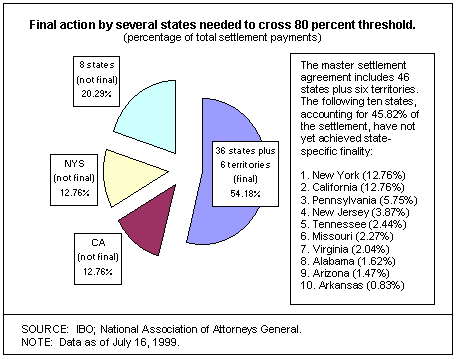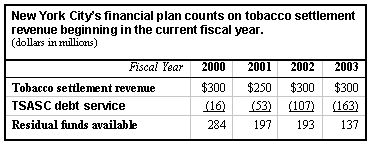
The Giuliani Administration continues its drive to securitize New York City's share of the national tobacco settlement proceeds. However, there may be bumps in the road ahead.
How Much Will the City Receive? New York State and its localities are to share $25 billion over 25 years. The current court settlement affirms the division of the funds between New York State (about 51 percent, or $12.8 billion), New York City (about 27 percent, or $6.7 billion), and the other 57 counties (about 22 percent, or $5.5 billion). These shares have been challenged by New York City and Westchester and Erie Counties. New York City believes it is entitled to 36 percent of the state's settlement based on the city's health care expenditures on smoking-related illnesses.
When Will the City Start Receiving the Funds? Until New York State resolves this intra-state dispute-achieving "confirmed state-specific finality"-it will not receive any settlement funds. These jurisdictions presented their cases to an appellate court in June. On July 16th, the appellate court ruled in favor of the state. Nevertheless, additional appeals could further delay New York State's participation in the settlement.
Even if New York resolves the appeal process in the near future, disbursement of the funds may be delayed until July 2000. Release of the funds before then requires that states entitled to 80 percent of the settlement payments to finalize any legal challenges. Crossing this threshold still requires action by several other states.
Since IBO's March update on the tobacco settlement, one roadblock to the funds has been removed. President Clinton's budget for 2000 raised the prospect that the federal government would claim roughly half of the settlement funds. Congress, however, intervened on behalf of the states in May, enacting legislation that prevents the federal government from taking a share of these settlement monies.

What Will the City Do With the Money? The Mayor's financial plan assumes that most of the funds will finance $2.5 billion ($625 million per year from 2000 to 2003) of debt issued to support the city's capital program; the rest would be available for other spending. The city recently created the Tobacco Settlement Asset Securitization Corporation (TSASC) to receive the payments and issue tax-exempt bonds backed by the settlement revenue. TSASC would receive the city's $250 million to $300 million in annual settlement revenue and use it to pay bondholders. The balance would then be placed in a TSASC trust fund, which the city would use to support other spending. This mechanism shields the city from the obligation to support the bonds and from having the debt count toward the city's debt limit. Since the debt limit would otherwise be reached this fiscal year, TSASC would provide additional capacity to finance the city's planned capital program, including its commitment to spend $6.15 billion over five years on school construction and modernization.

Because TSASC revenue would exceed the debt service on the bonds, additional funds would be available-particularly in the near term. The financial plan assumes these residual funds will finance other spending: $284 million in fiscal year 2000, $197 million in fiscal year 2001, $193 million in fiscal year 2002, and $137 million in fiscal year 2003. It should be noted that the financial plan is carrying $13 million per year for new anti-smoking education programs.
For more information on this topic contact Robert Weiner, a Senior Budget and Policy Analyst at IBO, at (212) 442-0332.